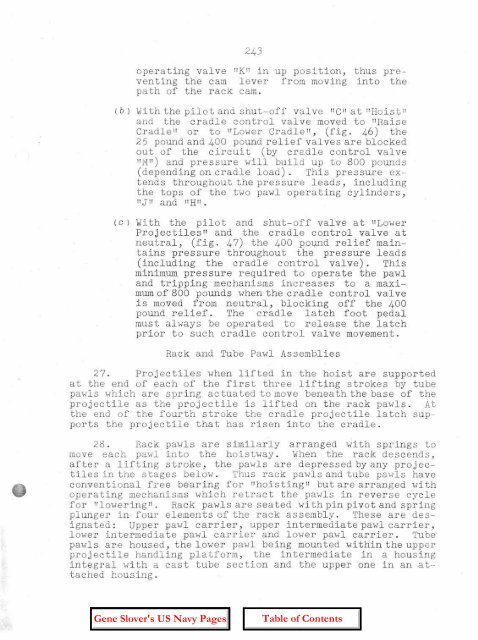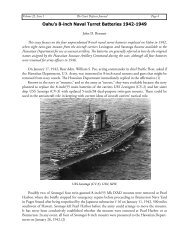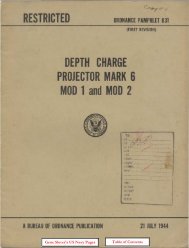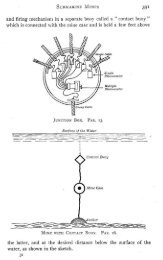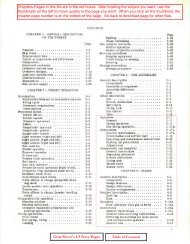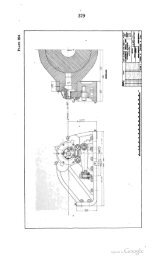OP-755 Part 2 Pages 197-401 - Personal Page of GENE SLOVER
OP-755 Part 2 Pages 197-401 - Personal Page of GENE SLOVER
OP-755 Part 2 Pages 197-401 - Personal Page of GENE SLOVER
You also want an ePaper? Increase the reach of your titles
YUMPU automatically turns print PDFs into web optimized ePapers that Google loves.
243<br />
opera ting valve I1KIIin up position, thus preventing<br />
the cam lever from moving into the<br />
path <strong>of</strong> the rack cam.<br />
(b) with the pilot and shut-<strong>of</strong>f valve "C" at "Ho Lst "<br />
and the cradle control valve moved to "Ra l s e<br />
Cradle il or to IILower Cradle II, (fig. 46) the<br />
25 pound and 400 pound relief valves are blocked<br />
out <strong>of</strong> the c Lr-cui t (by cr adI e control valve<br />
IM") and pressure will build up to 800 pounds<br />
(depending on cradle load). This pressure extends<br />
throughout the pressure leads, including<br />
the tops <strong>of</strong> the two pawl operating cylinders,<br />
I1JII and IIHII. .<br />
(C) with the· pilot and shut-<strong>of</strong>f valve at I1Lower<br />
Proj ectiles II and the cradle corrt r-oL valve at<br />
neutral, (fig. 47) the 400 povnd relief maintains<br />
pressure throughout the pressure leads<br />
(including the cradle control valve). This<br />
minimum pressure required to. operate the pawl<br />
and tripping· mechanisms increases to a maximum<strong>of</strong><br />
800 pounds when the cradle control valve<br />
is moved f'r-om neutral, blocking <strong>of</strong>f the 400<br />
pound relief. The cradle latch foot pedal<br />
must always be operated to release the latch<br />
prior to such cradle co.ntrol valve movement.<br />
Rack and Tube Pawl Assemblies<br />
27. Projectiles when lifted in the hoist are supported<br />
at the end <strong>of</strong> each <strong>of</strong> the first three lifting strokes by tube<br />
pawls which are spring ac tua ted to move beneath the base <strong>of</strong> the<br />
projectile as the projectile is lifted on the rack pawls. At<br />
the end <strong>of</strong> the fourth stroke the cradle projectile latch supports<br />
the projectile that has risen into the cradle.<br />
28. Rack pawls are similarly arranged with springs to<br />
move each pawl into. the hoistway. when the rack descends,<br />
after a lifting stroke, the pawls are depressed by any proj ectiles<br />
in the stages below. Thus rack pawls and tube pawls have<br />
conventional f r ee bearing for "hoisting II but are arranged with<br />
operating mechanisms which retract the pawls in reverse cycle<br />
for Illowering li • Rack pawls are seated with pin pivot and spring<br />
plunger in four elements <strong>of</strong> the rack assembly. These are designa<br />
ted: Upper pawl carrier, upper intermediate pawl carrier,<br />
lower intermediate pawl carrier and lower pawl carrier. Tube<br />
pawls are housed, the lower pawl being mount ed within the upper<br />
projectile handling platform, the intermediate in a housing<br />
integral with a cast tube section and the upper one in an attached<br />
housing.


